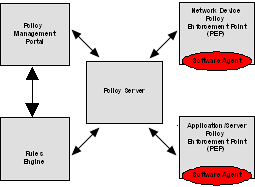 Pipeline Publishing, Volume 4, Issue 4 Pipeline Publishing, Volume 4, Issue 4 |
 |
This
Month's Issue: |
Maintaining Network Health |
|
|
|
Network, Heal Thyself!
Technological Advances Put Building Blocks in Place to Create Self-Healing, Reactive Network Architecture |
|
|
|
|
|
|

article page
| 1 | 2 | 3 |
All that is required is to carefully arrange these technologies into a cohesive and functional working system, and that begins with the actual network devices. Traditional networking devices have proprietary and closed architectures that expose to the end user very few services, except for basic transport services configured via the command line or mechanisms that enable the loading of whole configuration files from network management systems.
New networking devices being introduced into the market today are breaking that mold. Instead, they are shipping with fully open architectures that enable end-users to build and run applications directly on the device or on service blades within the device. In some
|
|
This rules engine must be capable of sophisticated logic patterns so that complex conditional decisions can be made. |
|

then achieved by simply pushing the proper configuration template down onto the device. This is not true policy-based networking.
The new generation of policy-based technologies now available in the market function at a higher level of abstraction from the network device and are far more powerful than these traditional template servers. These new policy servers are able to capture end-user requests through intuitive, non-technical interfaces and use these
|
|
|

cases, the device actually exposes the underlying kernel services and interface capabilities through a SOA layer where the external application or end user can toggle the behavior of the device through these exposed levers. The open nature of the device allows for robust application-level agents to be run on the device. These agents are capable of not only driving the device behavior, but also listening to the device and gleaning operational and service performance statistics in real time.
The ability to manipulate the device while simultaneously receiving real-time feedback is critical to the next building block required for the solution: the policy server. Although not a new concept, there have been steady advancements in policy-based networking technologies and these technologies are now capable of providing the control and automation functionality required for a truly dynamic, self-healing network.
Too frequently, the term ‘policy server’ has been used by the network management vendors to define template servers that manage device-level configuration files. In these solutions, network engineers build a static configuration file that meets their requirements then save the configuration as a template. Each subsequent device load is
|
|

requests to define, implement, and govern the behaviors of the underlying network devices and services.
In this example (Figure 1), the policy server becomes the heart of a dynamic self-healing network as it provides the necessary intelligence that recognizes events within, and external to, the network and determines how the network should be reconfigured based on defined events.

Fig. 1: Policy server is central to the self-healing network
article page
| 1 | 2 |
3 |
|
|
|
|
|
|
|
|





